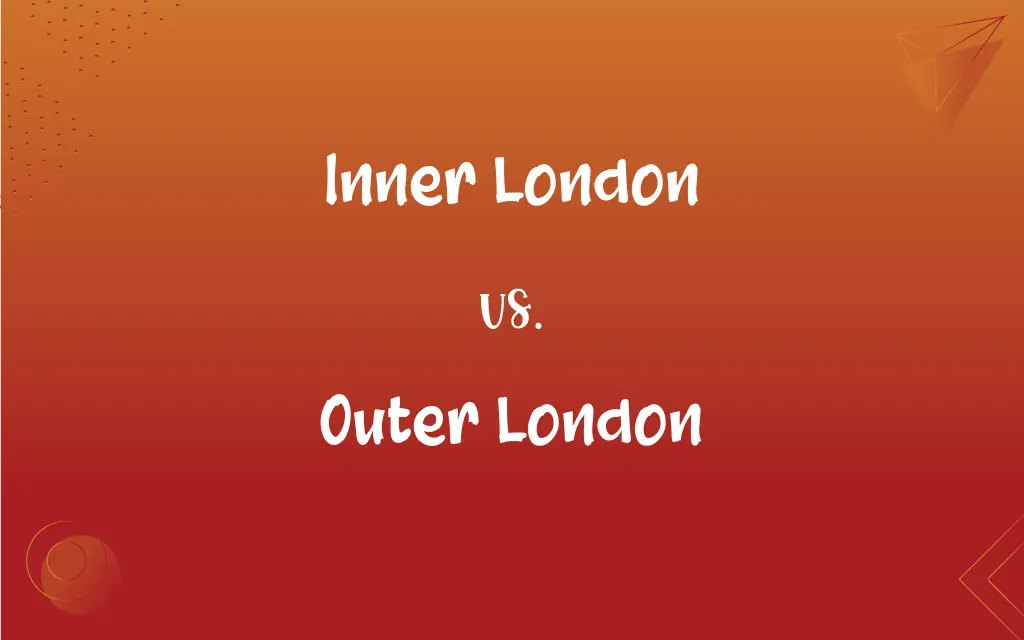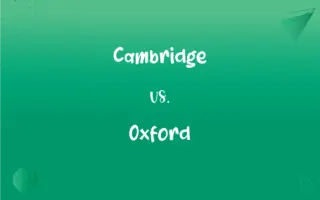Inner London vs. Outer London: What's the Difference?
Edited by Aimie Carlson || By Harlon Moss || Updated on October 11, 2023
Inner London is the densely populated and historically significant core of London; Outer London is the suburban, often more residential area that surrounds the inner boroughs, generally providing more space and greener environments.

Key Differences
Inner London refers to the set of 12 boroughs that represent the most central, historically rich, and economically vibrant part of London. These boroughs, including Camden, Greenwich, and Westminster, have traditionally been focal points of commerce, governance, and culture. On the contrary, Outer London consists of 20 boroughs such as Bexley, Havering, and Croydon, and usually exhibits a more suburban character, often housing residential neighborhoods and providing additional space compared to the bustling core of Inner London.
When examining demographics, Inner London tends to showcase a diverse, highly populated environment with a multitude of cultures, languages, and ethnicities coexisting. The area often features a denser population with a vibrant, cosmopolitan atmosphere. In contrast, Outer London, while still diverse, may offer a quieter, somewhat more homogeneous and family-oriented environment, providing residential options that might be more conducive to family living and arguably providing more green spaces.
Regarding economic and employment sectors, Inner London often stands out as a hub for finance, governance, and the creative industries, hosting an array of institutions, organizations, and businesses central to both London's and the UK’s economy. Alternatively, Outer London, while still harboring various businesses, might lean more towards retail, local services, and in some instances, industrial sectors, providing different employment opportunities and economic structures.
The architectural and spatial aspects of Inner London often reveal compact, historically, and architecturally significant structures, which could range from notable landmarks to preserved buildings reflecting varied historical periods. In distinction, Outer London may present a mixture of architectural styles but generally provides more modern housing options, and potentially, larger residential properties with access to wider open spaces.
From a tourism and lifestyle perspective, Inner London is frequently the epicenter of tourist activity, hosting renowned museums, galleries, theaters, and landmarks, thereby being a key point of interest for visitors to the city. In juxtaposition, Outer London might provide a retreat from the bustling city life, offering quieter neighborhoods, local parks, and potentially a more laid-back lifestyle, yet with its own points of interest and cultural sites.
ADVERTISEMENT
Comparison Chart
General Character
Central, historically significant
Suburban, residential
Demographic Nature
Densely populated, highly diverse
Less dense, can be more family-oriented
Economic Sectors
Focus on finance, governance, and creativity
May lean towards retail, local services
Architectural Style
Often historical and compact
Typically more modern, potentially spacious
Lifestyle and Tourism
Busy, tourist-centric, vibrant nightlife
Quieter, local-centric, potentially relaxed
ADVERTISEMENT
Inner London and Outer London Definitions
Inner London
Central, economically vibrant boroughs of London.
Inner London is globally recognized for its significant financial district.
Outer London
A part of London often characterized by more modern housing and infrastructure.
Many residents in Outer London enjoy the benefits of more recent housing developments.
Inner London
Historically and architecturally significant part of London.
Inner London boasts numerous landmarks like the Tower Bridge and the British Museum.
Outer London
A section of London that can provide different economic and employment opportunities, often in retail or local services.
Outer London hosts various retail centers and local businesses that serve the resident communities.
Inner London
The core of tourism and metropolitan lifestyle in London.
Tourists flock to Inner London to explore its rich history and vibrant life.
Outer London
A region with potentially more green spaces compared to its inner counterpart.
The numerous parks in Outer London provide ample space for outdoor activities.
Inner London
A densely populated, culturally diverse area.
Inner London hosts a multitude of cultural festivals celebrating its diverse population.
Outer London
An area that may offer a quieter, more localized lifestyle than the bustling core.
Living in Outer London often involves a peaceful environment with a tight-knit community feel.
Inner London
A key area for governance and creative industries.
Inner London houses the UK’s government and numerous art galleries.
Outer London
The suburban, more residential area surrounding central London.
Outer London offers a variety of family-friendly neighborhoods.
FAQs
How can Outer London be described geographically?
Outer London comprises 20 boroughs that are generally suburban and encircle the inner boroughs.
What is a key economic feature of Inner London?
Inner London is an economic hub, particularly in finance, governance, and the creative industries.
What is the lifestyle like in Inner London?
Inner London tends to have a vibrant, bustling lifestyle with numerous amenities and events.
Does Outer London host historical sites?
Yes, while possibly fewer, Outer London also has historical sites and local heritage landmarks.
How does the population density compare between the two?
Inner London typically has a higher population density compared to the more spaced-out Outer London.
How does the lifestyle in Outer London compare?
Outer London might offer a quieter, potentially more family-oriented lifestyle with local community events.
Does Inner London have many green spaces?
While Inner London has parks, Outer London often provides more extensive green spaces.
Are educational institutions distributed evenly across both areas?
Both areas host educational institutions, but Inner London might have a denser concentration of universities.
How diverse is the job market across both areas?
Both areas offer diverse opportunities but may specialize in different sectors (e.g., finance in Inner, retail in Outer).
Is Outer London less diverse than Inner London?
Not necessarily, but Inner London is often seen as especially cosmopolitan and diversely populated.
Is Inner London mainly residential?
While it has residential areas, Inner London is also heavily commercial and administrative.
Is there a distinction in architectural style between the two?
Inner London often features historical architecture, while Outer London may offer more modern residential structures.
What are housing costs like in Inner vs. Outer London?
Typically, housing can be more expensive in Inner London compared to Outer London due to demand and location.
Can Outer London be considered peaceful in comparison?
Outer London is often seen as offering more peaceful, residential environments, though this can vary.
Are there many historical landmarks in Inner London?
Yes, Inner London is rich in historical landmarks, such as the Houses of Parliament and Tower Bridge.
How does transportation in Outer London compare to Inner London?
Outer London may have less dense transportation networks than the extensively connected Inner London.
Is Inner London always busier than Outer London?
Generally yes, due to its commercial and administrative functions and tourist attractions.
Do both Inner and Outer London have local governance?
Yes, both Inner and Outer London boroughs have their local councils managing various aspects of governance.
What characterizes Inner London geographically?
Inner London consists of 12 central boroughs that are historically and economically significant.
Which sectors are prevalent in Outer London?
Outer London often features sectors like retail, local services, and potentially industry.
About Author
Written by
Harlon MossHarlon is a seasoned quality moderator and accomplished content writer for Difference Wiki. An alumnus of the prestigious University of California, he earned his degree in Computer Science. Leveraging his academic background, Harlon brings a meticulous and informed perspective to his work, ensuring content accuracy and excellence.
Edited by
Aimie CarlsonAimie Carlson, holding a master's degree in English literature, is a fervent English language enthusiast. She lends her writing talents to Difference Wiki, a prominent website that specializes in comparisons, offering readers insightful analyses that both captivate and inform.































































